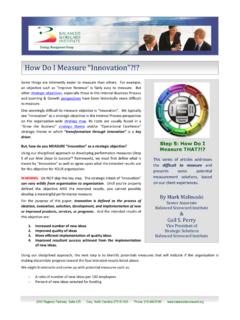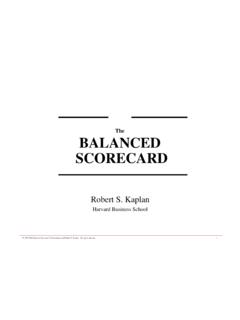Transcription of Using the Balanced Scorecard to Align Your Organization
1 2000 Regency Parkway, Suite 420 Cary, North Carolina 27518 USA +1 Using the Balanced Scorecard to Align your Organization By Howard Rohm Co-founder & President Balanced Scorecards, when developed as strategic planning and management systems, can help Align an Organization behind a shared vision of success, and get people working on the right things and focusing on results. A Scorecard is more than a way of keeping is a system, consisting of people, strategy, processes, and technology. One needs a disciplined framework to build the Scorecard system. This article is the first in a series describing how to build and implement a Balanced Scorecard system Using a systematic step-by-step approach.
2 Balanced Scorecard means different things to different people. At one extreme, a measurement-based Balanced Scorecard is simply a performance measurement framework for grouping existing measures into categories, and displaying the measures graphically, usually as a dashboard. The measures in these systems are usually operational, not strategic, and are used primarily to track production, program operations and service delivery (input, output, and process measures). At the other extreme, the Balanced Scorecard is a robust Organization -wide strategic planning, management and communications system. These are strategy-based systems that Align the work people do with Organization vision and strategy, communicate strategic intent throughout the Organization and to external stakeholders, and provide a basis for better aligning strategic objectives with resources.
3 In strategy-based Scorecard systems, strategic and operational performance measures (outcomes, outputs, process and inputs) are only one of several important components, and the measures are used to better inform decision making at all levels in the Organization . In strategy-based systems, accomplishments and results are the main focus, based on good strategy executed well. A planning and management Scorecard system uses strategic and operational performance information to measure and evaluate how well the Organization is performing with financial and customer results, operational efficiency, and Organization capacity building. Performance measurement Balanced scorecards are not very interesting and add little business intelligence to help an Organization chart strategic direction and measure the progress of strategic execution.
4 Balanced scorecards built with the goal of organizing the measures we have hardly justify the energy it takes to build them. We ll start our Balanced Scorecard journey not from performance measures but from the results we want the Organization to accomplish. In other words, we ll start with the end in mind, not with the measures we currently have. One of Stephen Covey s quote captures the essence of our journey: People and their managers are working so hard to be sure things are done right, that they hardly have time to decide if they are doing the right things. Doing the right things and doing things right is a balancing act and requires the development of good business strategies (doing the right things) and efficient processes and operations to deliver 2 2000 Regency Parkway, Suite 420 Cary, North Carolina 27518 USA +1 the programs, products and services (doing things right) that make up the Organization s core business.
5 While there are differences in development and implementation of Scorecard systems for private, public and nonprofit organizations, the disciplined process of strategic discovery used to develop Scorecard systems has more similarities than differences, so the framework we will describe applies equally well to different types of organizations, as well as to different size organizations. We have applied the framework to businesses, nonprofits, and government organizations with less than 10 employees to organizations with more than 100,000. Developing a Balanced Scorecard system is like putting a puzzle together, where different pieces come together to form a complete mosaic. In the Balanced Scorecard , the pieces are strategic components that are built individually, checked for fit against other strategic components, and assembled into a complete system.
6 The major components of a Balanced Scorecard system are shown in Table 1 and summarized briefly in the paragraphs that follow. Future newsletter articles will explore each of the major system components and describe how each piece of the puzzle is build and connected to other pieces. Table 1: Balanced Scorecard System Elements Engaged Leadership Strategic Objectives Interactive Communications & Change Customer-Facing Value Creation Strategy (Strategy Map) Management Evaluation Vision and Mission Performance Measures, Targets & Thresholds Core Values Strategic Initiatives Organization Pains & Enablers Performance Information Reporting Customers and Stakeholders Department & Individual Scorecards (Cascade) Customer Value Proposition Rewards & Recognition Program Strategy (Perspectives, Strategic Themes, and Strategic Results) Engaged Leadership, Interactive Communications and Change Management.
7 Developing a Scorecard system is transformational for an s about changing hearts and minds. Leaders who are engaged in the discovery process, communication via two-way dialogue, and planning and managing change are important first steps in the process. Organization Mission, Vision, and Values. Critical to an aligned Organization are a well-defined mission, a shared vision, and Organization values that are built on strong personal values. Most organizations have these components, but often there is no connecting tissue among the components that allow employees to get it easily. A compelling and clear picture of the future (the shared vision) is where the Scorecard development process buy-in follows as hearts and minds are engaged in creating and executing the Organization s strategies.
8 Organization Pains (Weaknesses) and Enablers (Strengths). An Organization environmental scan ( climate survey ) will identify internal and external pains and enablers that will drive strategy creation and the approach to achieving future results. Customers and Stakeholders, and the Value Proposition. Effective strategy incorporates a view from the customer and stakeholder perspective, and includes an understanding of customer needs, product and service characteristics, desired relationships and the desired corporate image that the Organization wants to portray. Perspectives, Strategic Themes, and Strategic Results. To view strategy through different performance lenses ( Balanced Scorecard perspectives), the Organization needs to define strategic perspectives, key strategies and expected results.
9 Key strategies are the main focus areas or pillars of excellence that translate business strategy into operations and make strategy actionable to all employees. Strategic Objectives and Strategy Map. Strategic objectives are the building blocks of strategy (strategy DNA ), and objectives linked together in cause-effect relationships create a strategy map that shows how an Organization creates value for its customers and stakeholders. Performance Measures, Targets and Thresholds. Performance measures are linked to objectives and allow the Organization to measure what matters and track progress toward desired strategic results. Targets and thresholds provide the basis for visual interpretation of performance data, to transform the data into business intelligence.
10 3 2000 Regency Parkway, Suite 420 Cary, North Carolina 27518 USA +1 Strategic Initiatives. Initiatives translate strategy into operational terms and provide a basis for prioritizing the budget and identifying the most important projects for the Organization to undertake. Performance Information Reporting. Automated data collection and reporting processes are used to visualize performance information and better inform decision making throughout the Organization . Cascade Scorecards to Departments and Individuals. Align the Organization through strategy, Using the strategy map, performance measures and targets, and initiatives. Scorecards are used to improve accountability through objective and performance measure ownership.









